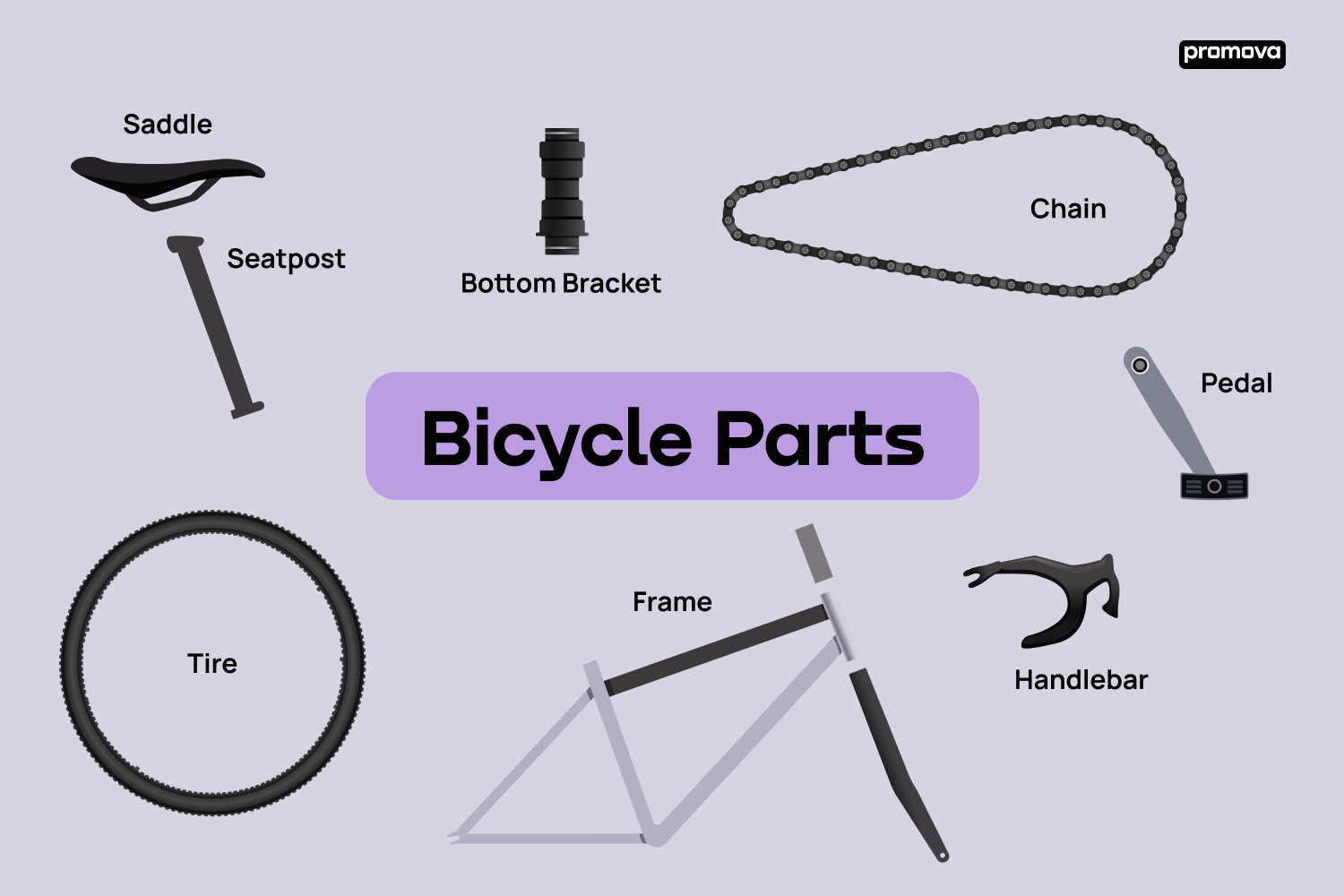Bicycle Parts Names
Contents
Learning English, like any other language, is enriched by understanding the vocabulary of daily activities and interests. One such universal interest is bicycling. Here, we dive into the terminology associated with the different bicycle parts' names.

Main Bicycle Parts Names
If you're a language learner, understanding the main bicycle part names can aid in comprehension and conversation with native speakers. It's essential to familiarize yourself with these terms, especially if you plan to ride or discuss bicycles.
- Frame: the main structure of the bicycle to which other components are attached; usually made of metal or carbon fiber.
- Wheel: the round part of a bicycle that rotates when the bicycle moves; consists of the rim, spokes, and hub.
- Tire: the rubber exterior of the wheel; makes contact with the ground.
- Saddle: the seat of the bicycle; where the rider sits.
- Handlebar: the part of the bicycle that the rider holds onto; used for steering.
- Fork: part of a bicycle that holds the front wheel; connects to the handlebar.
- Stem: connects the handlebars to the bicycle; provides stability.
- Seatpost: the tube that supports the saddle; can be adjusted for height.
- Headset: a part of a bicycle that provides a rotatable interface between the bicycle fork and the frame.
- Bottom bracket: the part of the frame where the crankset is mounted; allows for pedal rotation.
By acquainting yourself with these main bicycle part names, you're well-prepared to discuss bicycles more thoroughly and confidently.
Bicycle Drivetrain Components
The drivetrain of a bicycle refers to the parts involved in transferring power from the rider to the wheels. By mastering these parts of a bicycle, you can describe the mechanics of how it propels forward.
- Pedal: the part the rider pushes down on with their feet; initiates the bicycle’s movement.
- Chain: a series of linked metal pieces; transfers power from the pedals to the wheels.
- Crankset: the system of chains and gears near the pedals; includes the crank arms and chainrings.
- Derailleur: a mechanism that moves the chain between different gears; helps adjust the bicycle's speed.
- Cassette: a collection of gears located on the rear wheel; works with the chain to change speeds.
- Chainring: one or more metal rings attached to the crankset; engages the chain.
- Freewheel: a device allowing the rear wheel to turn without moving the pedals.
- Shifters: devices mounted on the handlebars; used to change gears.
- Jockey wheel: a small wheel in the rear derailleur; guides the chain.
- Bottom pull/front pull: types of derailleurs; defines the cable routing direction.
By familiarizing yourself with these extended drivetrain components, you'll be even more adept at discussing the complexities of bicycle motion and operation.
10
Bicycle Safety Equipment
When riding a bicycle, safety is paramount. The following bicycle parts list is crucial for language learners who prioritize their well-being while cycling or discussing safety equipment with others.
- Helmet: a protective headgear worn by cyclists; reduces the risk of head injuries.
- Lights: devices attached to the bicycle that emit light; ensure visibility in low-light conditions.
- Reflectors: shiny devices that reflect light; make the bicycle visible to others.
- Brake: a mechanism to slow down or stop the bicycle; can be hand-operated or foot-operated.
- Bell: a small device that makes a ringing sound; used to alert pedestrians and other cyclists.
- Gloves: protective wear for hands; improves grip and comfort.
- Protective pads: worn on knees and elbows; reduces injury during falls.
- Mirror: attached to handlebars or helmet; helps see traffic from behind.
- Horn: a loud device; used for signaling or warning.
- Fenders: metal or plastic guards over wheels; prevent mud or water from splashing.
Safety is holistic, and knowing these comprehensive terms ensures you can fully understand and discuss every aspect of bicycle safety.
Bicycle Maintenance Tools
Every bicycle enthusiast understands the importance of maintenance to ensure the bicycle stays in prime condition. Whether you're discussing routine care or solving specific problems, the following tools are vital for bicycle upkeep. As a language learner, knowing these terms will deepen your bicycle conversations and comprehension.
- Wrench: a tool used to turn bolts and nuts; comes in various sizes and types.
- Allen key: a hexagonal tool; used for tightening or loosening hex bolts commonly found on bicycles.
- Chain breaker: a tool that helps remove or replace links in a bicycle chain.
- Spoke wrench: designed to adjust the tension of the spokes on a bicycle wheel.
- Tire levers: small tools that assist in removing the tire from the wheel's rim.
- Patch kit: a collection of items, including adhesive and patches; used to repair small holes in bicycle tires.
- Pump: a device for inflating bicycle tires; can be foot-operated or hand-operated.
- Grease: a thick lubricant; used to reduce friction in bicycle parts like bearings.
- Cleaning brush: a tool with bristles; helps in cleaning various parts of the bicycle, especially the drivetrain.
- Cable cutter: a tool specifically designed for cutting the steel cables used for brakes and gears.
Now, equipped with the vocabulary of essential maintenance tools for parts of the bicycle, you're ready to dive deeper into discussions about bicycle upkeep. Understanding these terms not only benefits your linguistic skills but also empowers you in the practical realm of bicycle care.
Conclusion
Mastering the vocabulary of any subject deepens your understanding and ability to communicate effectively. With this extended guide on bicycle parts’ names, you're now thoroughly equipped to converse about bicycling in English.
Comments